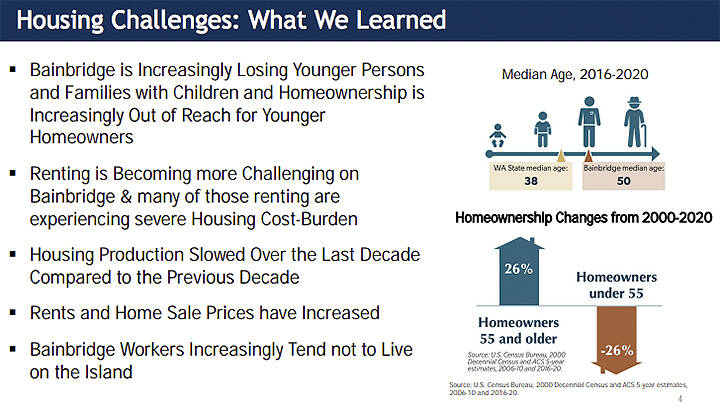The Housing Action Plan was a big hit with Bainbridge Island City Councilmembers April 18.
“It exceeds my expectations by quite a lot,” deputy mayor Jon Quitslund said. “This is really opening big doors to our future.”
He said it provides specific steps. He added the BI Planning Commission can help with “problematic” code that needs changing to get things done.
Mayor Brenda Fantroy-Johnson also likes the plan and said it needs to be used instead of sitting on a shelf like so many other reports.
Councilmember Clarence Moriwaki said he likes that the report shows which projects can be done more quickly and which ones are more expensive and will take time.
Fantroy-Johnson said, “Let’s check off some of this low-hanging fruit.”
Likewise, Councilmember Joe Deets likes the report and wants to make sure they stay on task and use it.
Councilmember Kirsten Hytopoulos said she would like to see prioritization of the projects. She would like to see more options like common ownership, rather than traditional family units.
Councilmember Leslie Schneider agreed. She mentioned co-living arrangements where people rent a bedroom and share resources like a living area, bathrooms and a kitchen. To help people stay in their homes, and not have to move because of high property taxes, she mentioned another program. In essence, the city would gain the property and roll back the value of the property to lower the taxes.
Fantroy-Johnson said anything that’s done has to get buy-in from the public. She added that some people aren’t going to like code being changed. “But we’ll be in control of what we do instead of someone else regarding affordable housing.”
HAP will now go to the Planning Commission, which will have a public meeting before sending it back to the council for a vote.
The opening presentation on HAP says a grant requires approval by June 30. The presentation says the plan should be supported by data, community engagement and a review of policies. It also should identify actions that can help BI address housing needs. A Department of Commerce grant requires both affordable and market-rate housing; and different types of housing for the next 20 years.
The presentation continues saying BI is losing young people as home ownership is out of reach. Many who work here can’t afford to live here. Renting also is challenging. Housing production has slowed, and prices have risen. It also says seniors are struggling to stay on BI because rising housing prices mean higher taxes. It’s also hard for them to downsize due to a lack of housing.
HAP strategies include:
1. More diverse housing: such as tiny homes, cottage housing and accessory dwelling units.
2. Increase affordable housing: enact incentives and allocate resources, even funding.
3. Prevent displacement: implement housing stability tools.
4. Housing for seniors: and others with unique needs. Transitional and supportive housing.
5. More housing for workers: promote housing for employees.
6. Encourage sustainable development: increase housing in designated centers.
Short-term examples include updating code supporting small-housing options. Medium-term examples include improve the Multifamily Tax Exemption Program. And long-range examples include a local affordable housing levy.



